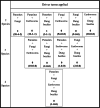Biotic interactions in soil and dung shape parasite transmission in temperate ruminant systems: An integrative framework
- PMID: 38426805
- PMCID: PMC11476215
- DOI: 10.1002/eap.2956
Biotic interactions in soil and dung shape parasite transmission in temperate ruminant systems: An integrative framework
Abstract
Gastrointestinal helminth parasites undergo part of their life cycle outside their host, such that developmental stages interact with the soil and dung fauna. These interactions are capable of affecting parasite transmission on pastures yet are generally ignored in current models, empirical studies and practical management. Dominant methods of parasite control, which rely on anthelmintic medications for livestock, are becoming increasingly ineffective due to the emergence of drug-resistant parasite populations. Furthermore, consumer and regulatory pressure on decreased chemical use in agriculture and the consequential disruption of biological processes in the dung through nontarget effects exacerbates issues with anthelmintic reliance. This presents a need for the application and enhancement of nature-based solutions and biocontrol methods. However, successfully harnessing these options relies on advanced understanding of the ecological system and interacting effects among biotic factors and with immature parasite stages. Here, we develop a framework linking three key groups of dung and soil fauna-fungi, earthworms, and dung beetles-with each other and developmental stages of helminths parasitic in farmed cattle, sheep, and goats in temperate grazing systems. We populate this framework from existing published studies and highlight the interplay between faunal groups and documented ecological outcomes. Of 1756 papers addressing abiotic drivers of populations of these organisms and helminth parasites, only 112 considered interactions between taxa and 36 presented data on interactions between more than two taxonomic groups. Results suggest that fungi reduce parasite abundance and earthworms may enhance fungal communities, while competition between dung taxa may reduce their individual effect on parasite transmission. Dung beetles were found to impact fungal populations and parasite transmission variably, possibly tied to the prevailing climate within a specific ecological context. By exploring combinations of biotic factors, we consider how interactions between species may be fundamental to the ecological consequences of biocontrol strategies and nontarget impacts of anthelmintics on dung and soil fauna and how pasture management alterations to promote invertebrates might help limit parasite transmission. With further development and parameterization the framework could be applied quantitatively to guide, prioritize, and interpret hypothesis-driven experiments and integrate biotic factors into established models of parasite transmission dynamics.
Keywords: agroecology; agroecosystems; biocontrol; parasite control; sustainable agriculture.
© 2024 The Authors. Ecological Applications published by Wiley Periodicals LLC on behalf of The Ecological Society of America.
Conflict of interest statement
The authors declare no conflicts of interest.
Figures




Similar articles
-
The impact of dung beetles on the free-living stages of ruminant parasites in faeces and their role as biological control agents in grazing livestock.Vet Parasitol. 2024 Oct;331:110267. doi: 10.1016/j.vetpar.2024.110267. Epub 2024 Jul 17. Vet Parasitol. 2024. PMID: 39024696 Review.
-
Quantifying immediate and delayed effects of anthelmintic exposure on ecosystem functioning supported by a common dung beetle species.PLoS One. 2017 Aug 11;12(8):e0182730. doi: 10.1371/journal.pone.0182730. eCollection 2017. PLoS One. 2017. PMID: 28800623 Free PMC article.
-
The ecology of fish parasites with particular reference to helminth parasites and their salmonid fish hosts in Welsh rivers: a review of some of the central questions.Adv Parasitol. 2002;52:1-154. doi: 10.1016/s0065-308x(02)52011-x. Adv Parasitol. 2002. PMID: 12521260 Review.
-
Influence of nematophagous fungi, earthworms and dung burial on development of the free-living stages of Ostertagia (Teladorsagia) circumcincta in New Zealand.Vet Parasitol. 2002 Mar 1;104(2):119-29. doi: 10.1016/s0304-4017(01)00629-x. Vet Parasitol. 2002. PMID: 11809331
-
The impact of cattle dung pats on earthworm distribution in grazed pastures.BMC Ecol. 2018 Dec 19;18(1):59. doi: 10.1186/s12898-018-0216-6. BMC Ecol. 2018. PMID: 30567522 Free PMC article.
Cited by
-
The mite Machrocheles robustulus (Mesostigmata, Macrochelidae) a new promising natural enemy of Haemonchus contortus (Strongylida, Trichostrongylidae).Parasit Vectors. 2025 Aug 19;18(1):351. doi: 10.1186/s13071-025-06990-x. Parasit Vectors. 2025. PMID: 40830481 Free PMC article.
References
-
- Aguilar, J. A. C. , Mendoza‐de‐Gives P., López ‐Arellano M. E., and Liébano Hernández E.. 2008. “Evaluation of Multinutritional Pellets Containing Duddingtonia flagrans Chlamydospore for the Control of Ovine Haemonchosis.” Annals of the New York Academy of Sciences 1149: 161–163. - PubMed
-
- Ahmed, M. , Laing M. D., and Nsahlai I. V.. 2014. “Use of Clonostachy rosea against Sheep Nematodes Developing in Pasture.” Biocontrol Science and Technology 24(4): 389–398.
-
- Aira, M. , Monroy F., and Domínguez J.. 2006. “Eisenia Fetida (Oligochaeta, Lumbricidae) Activates Fungal Growth, Triggering Cellulose Decomposition during Vermicomposting.” Microbial Ecology 52(4): 738–747. - PubMed
-
- Aira, M. , Sampedro L., Monroy F., and Domínguez J.. 2008. “Detritivorous Earthworms Directly Modify the Structure, Thus Altering the Functioning of a Microdecomposer Food Web.” Soil Biology and Biochemistry 40(10): 2511–2516.
-
- Amaradasa, B. S. , and Manage R. A. L. A.. 2010. “Vertical Migration of Haemonchus contortus Infective Larvae on Cynodon dactylon and Paspalum notatum Pastures in Response to Climatic Conditions.” Veterinary Parasitology 170(1–2): 78–87. - PubMed
Publication types
MeSH terms
Substances
Grants and funding
LinkOut - more resources
Full Text Sources

